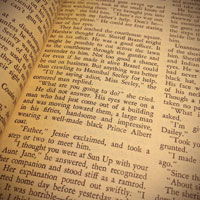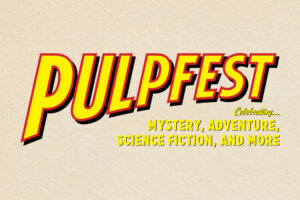 For those who aren’t familiar with the pulp magazines, it may appear that the colorful, illustrated cover of a pulp — or pulp reprint or replica — wraps around a fully-illustrated magazine, i.e. a comic book.
For those who aren’t familiar with the pulp magazines, it may appear that the colorful, illustrated cover of a pulp — or pulp reprint or replica — wraps around a fully-illustrated magazine, i.e. a comic book.
This was the assumption of several relatives over the Christmas holiday. It wasn’t the first time either. People frequently assume that the pulps were comic books. And generally, when they say “comic books” it is often with a certain disdain in their voice.
(To be fair, I’ve read my share of comic books over the years and appreciate graphic storytelling. What has turned me off of them is the entertainment-value-to-cost ratio. Paying about $4 for 15 minutes of entertainment doesn’t equal value. To put that in context: If a ticket to The Hobbit: An Unexpected Journey was valued at the same rate as comic books today, it would cost about $45 just to get in to see the movie — forget about a drink and a snack. But this should be a topic for a comic book blog; so back to the pulps.)
Whereas comic books are a visual form of literature, the pulp magazines contained (as most of you know) prose — short stories, novellas, novels, poems and the occasional article.
Of course, gloriously colorful paintings graced the covers, and inked illustrations often accompanied the stories inside.
There were instances of short comic strips appearing the pulps, but those were very limited. Take Spicy Detective Stories, which included four to six pages of a black-and-white “Sally the Sleuth” comic where she solved crime and always, curiously, ended up wearing nothing but her underwear. (It was “spicy” after all.)
Those limited examples aside, the pulps were filled with text — stories both poorly written and exceptionally crafted, and everything in between.
Brief rant concluded. Now back to reading an H. Bedford-Jones story.



A similar thing happens with British story papesr (‘Union Jack’ ‘Nelson Lee Library’, ‘Pluck’ etc.) which ran from the 1880s through the end of the 1940s. At their peak they were the rough British equivalent of the pulps, at least in terms of time frame, though perhaps less so in terms of content (serial detectives like Sexton Blake, and public school stories — the latter of which remain extremely popular today amongst a fanatic few). About the time the pulps were dying out in the US, say c. 1955, many of the British story papers had or were beginning to die out, and those which survived in one form or another shifted from all fiction to nearly all ‘comic strips’ (e.g. things like Prince Valiant). Hence younger members of scanners and collectors groups for story papers nowadays refer to even the old story papers as ‘comics’ — though they seldom carried any other graphics than one or two illustrations for the stories.
On the U.S. end, it’s probably a combination of a lack of knowledge about the pulps and a familiarity with comic books that causes the problem. I really shouldn’t blame anyone who has never seen a pulp magazine. (But it’s still a bit annoying.)